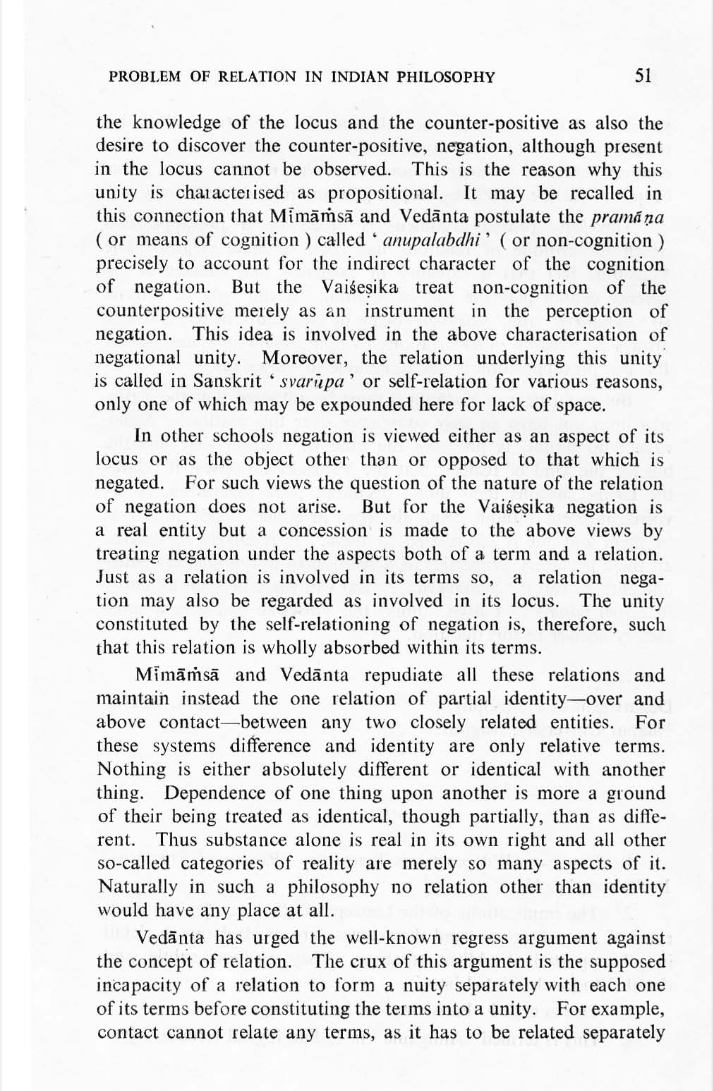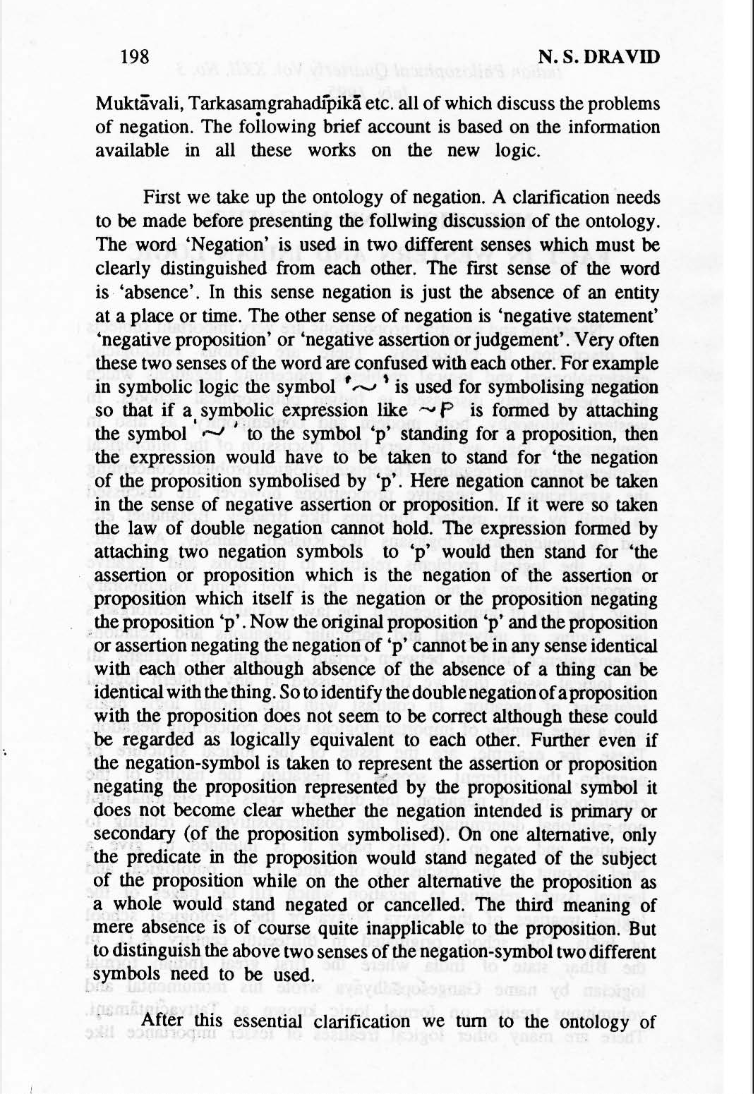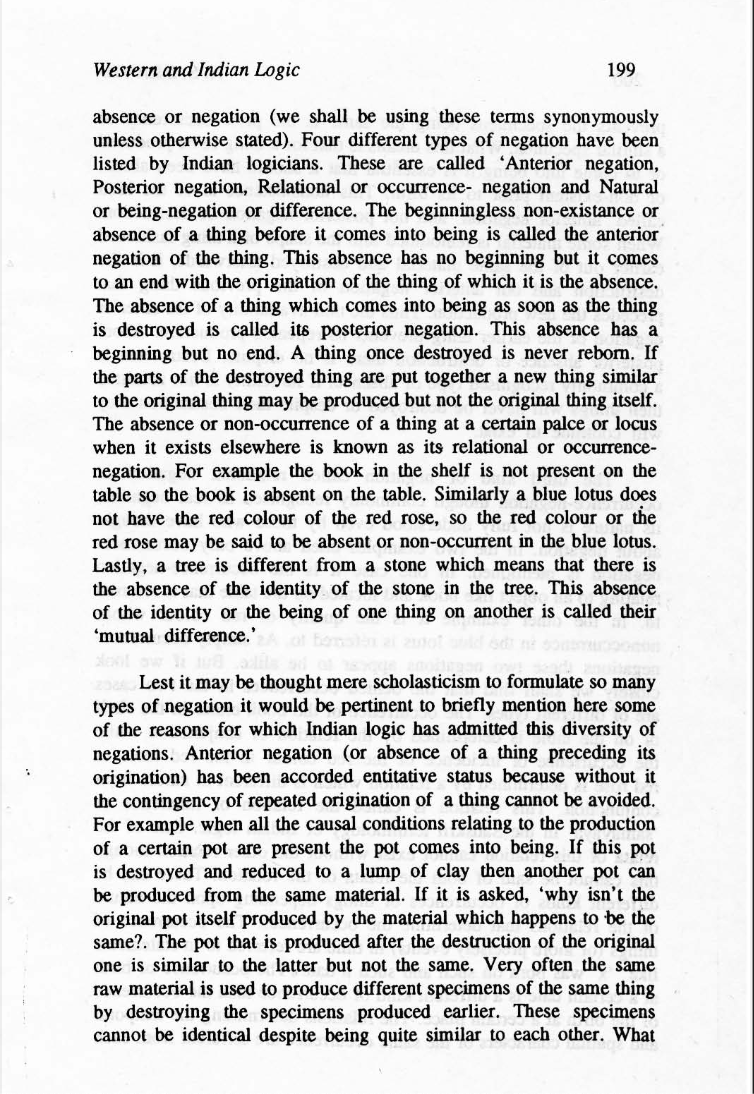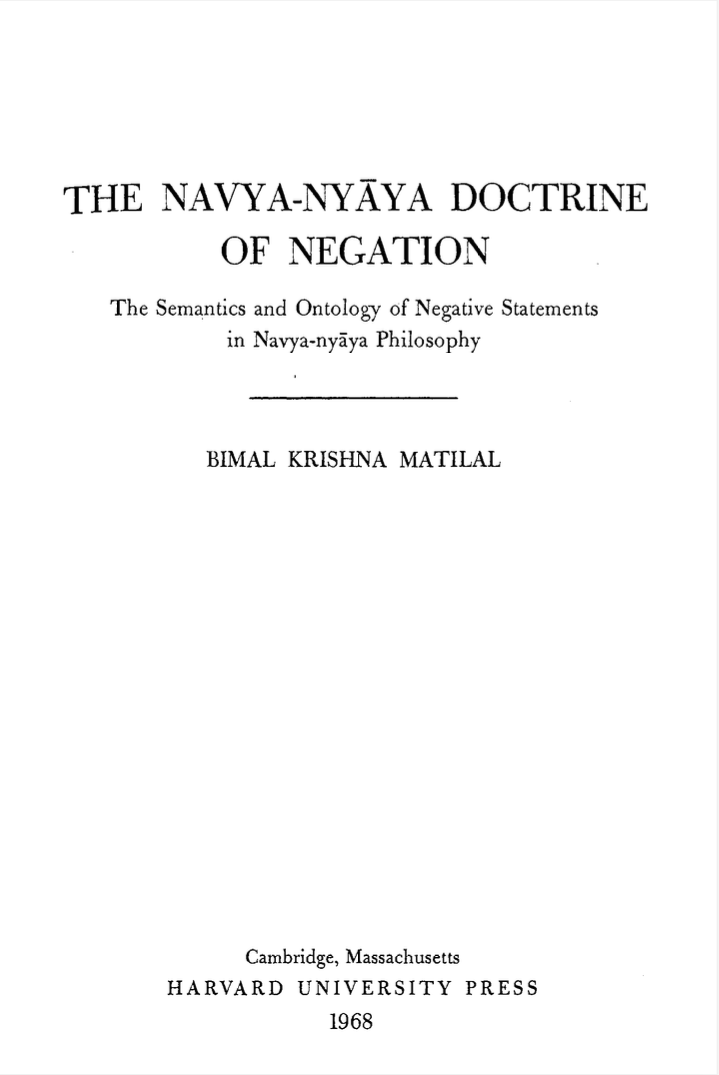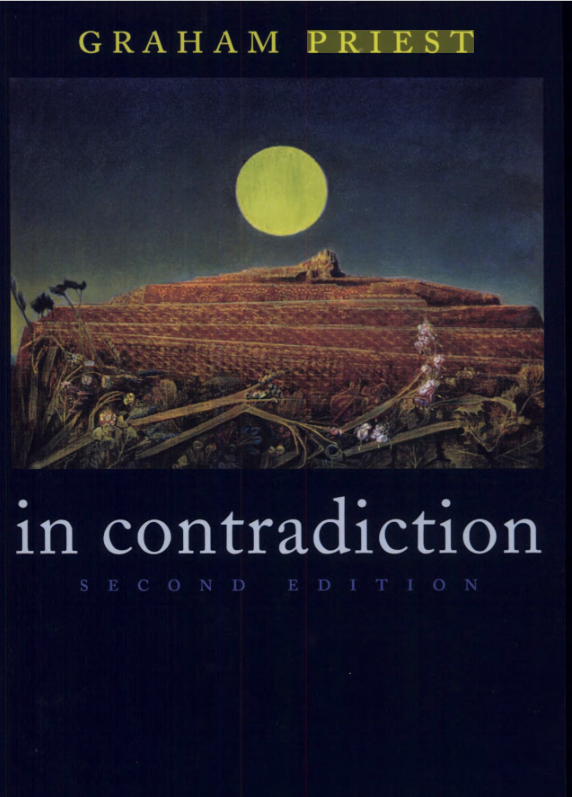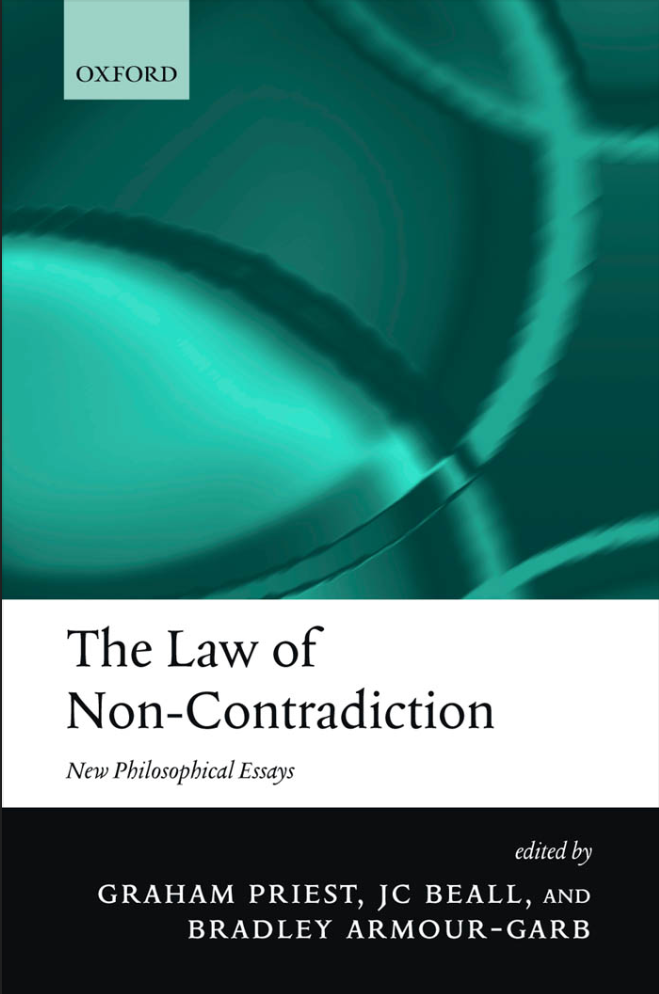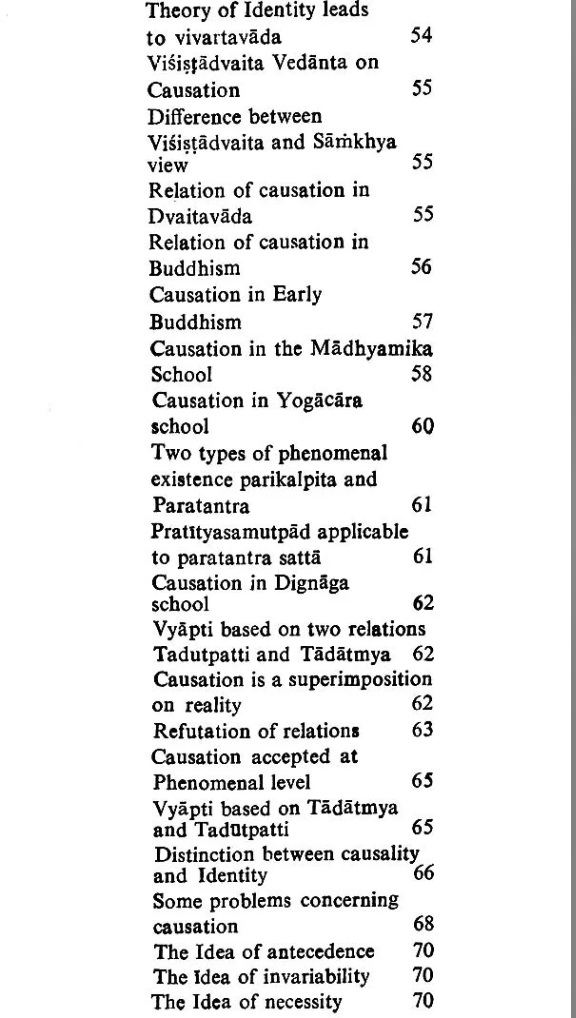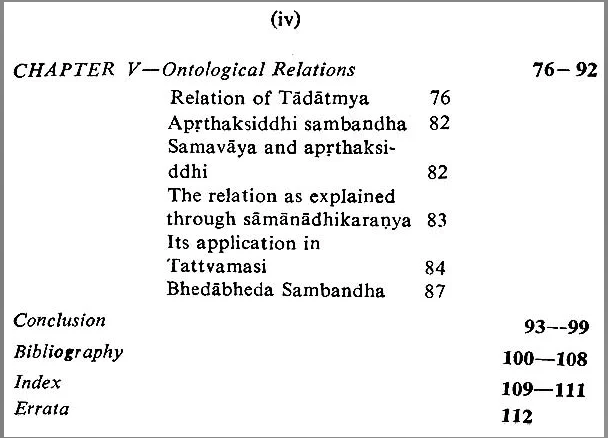The Fifth Corner of Four: Catuskoti in Buddhist Logic

Key Terms
- Logic
- Classical Logic
- Non Classical Logic
- Many Valued Logic
- Multi Valued Logic
- Three Valued Logic
- Four Valued Logic
- Catuskoti
- Buddhist Logic
- Lukasiewicz Logic
- Kleene Logic
- Intuitionistic Logic
- Five Valued Logic
Researchers
- Graham Priest
- Kreutz, Adrian
- Kapsner, Andreas
- Jan Westerhoff
- Hans Rudolf Kantor
- Gunaratne, R. D.
The Fifth Corner of Four: An Essay on Buddhist Metaphysics and the Catuṣkoṭi
Source: The Fifth Corner of Four: An Essay on Buddhist Metaphysics and the Catuṣkoṭi. By Graham Priest. New York: Oxford University Press, 2018. / Matthew T. Kapstein

Source: The Fifth Corner of Four: An Essay on Buddhist Metaphysics and the Catuṣkoṭi. By Graham Priest. New York: Oxford University Press, 2018. / Matthew T. Kapstein

Source: The Fifth Corner of Four: An Essay on Buddhist Metaphysics and the Catuṣkoṭi. By Graham Priest. New York: Oxford University Press, 2018. / Matthew T. Kapstein
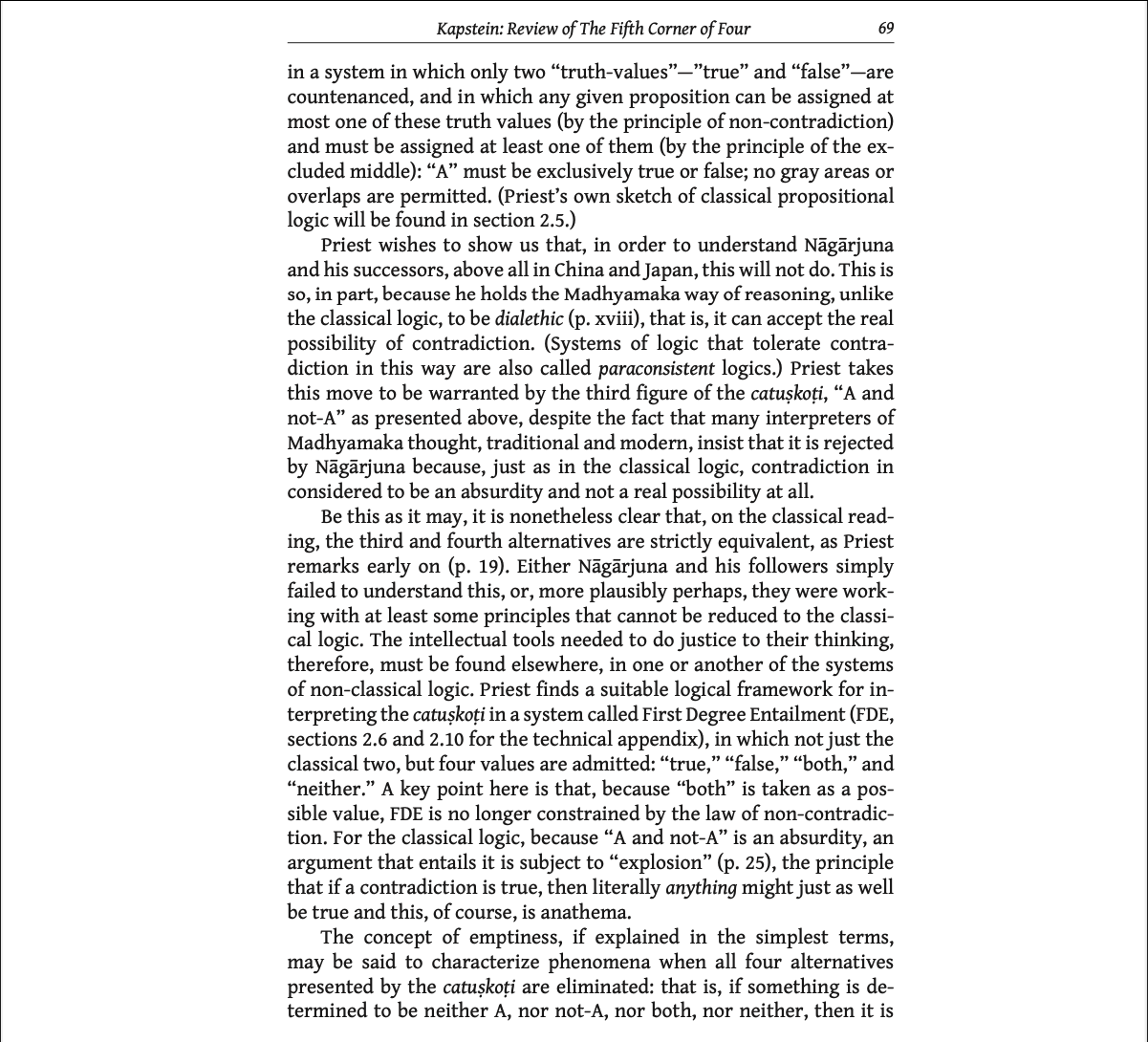
Source: The Fifth Corner of Four: An Essay on Buddhist Metaphysics and the Catuṣkoṭi. By Graham Priest. New York: Oxford University Press, 2018. / Matthew T. Kapstein

Source: The Fifth Corner of Four: An Essay on Buddhist Metaphysics and the Catuṣkoṭi. By Graham Priest. New York: Oxford University Press, 2018. / Matthew T. Kapstein

Source: The Fifth Corner of Four: An Essay on Buddhist Metaphysics and the Catuṣkoṭi. By Graham Priest. New York: Oxford University Press, 2018. / Matthew T. Kapstein

My Related Posts
You can search for these posts using Search Posts feature in the right sidebar.
- Relation and Negation in Indian Philosophy
- Hermann Weyl and L.E.J. Brouwer: Intuitive Continuum and Choice Sequences
- Charles Sanders Peirce’s Visual Logic: Diagrams and Existential Graphs
- Charles Sanders Peirce’s Theory of Signs
- Semiotics and Systems
Key Sources of Research
“Understanding Nāgārjuna’s Catuṣkoṭi.”
Gunaratne, R. D.
Philosophy East and West 36, no. 3 (1986): 213–34. https://doi.org/10.2307/1398772.
https://www.jstor.org/stable/1398772
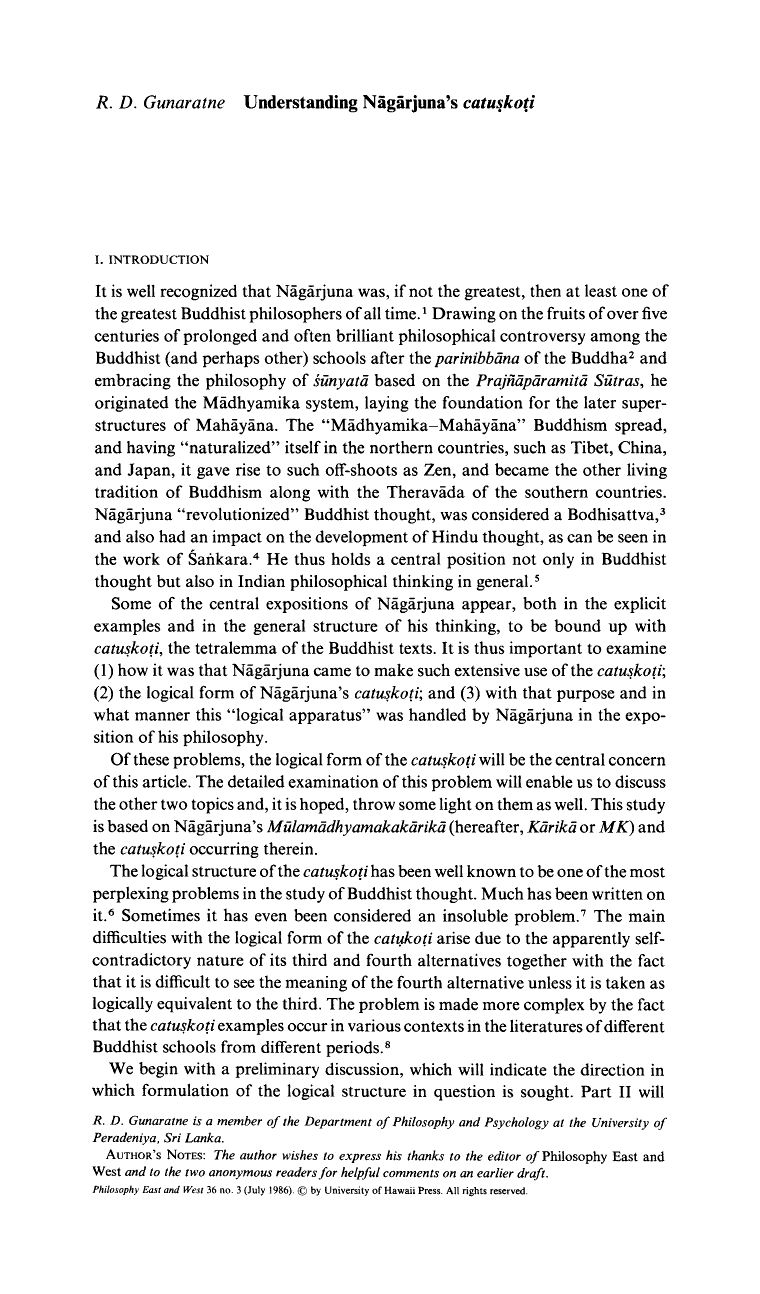
“The Logical Form of Catuṣkoṭi: A New Solution.”
Gunaratne, R. D.
Philosophy East and West 30, no. 2 (1980): 211–39. https://doi.org/10.2307/1398848.
https://www.jstor.org/stable/1398848
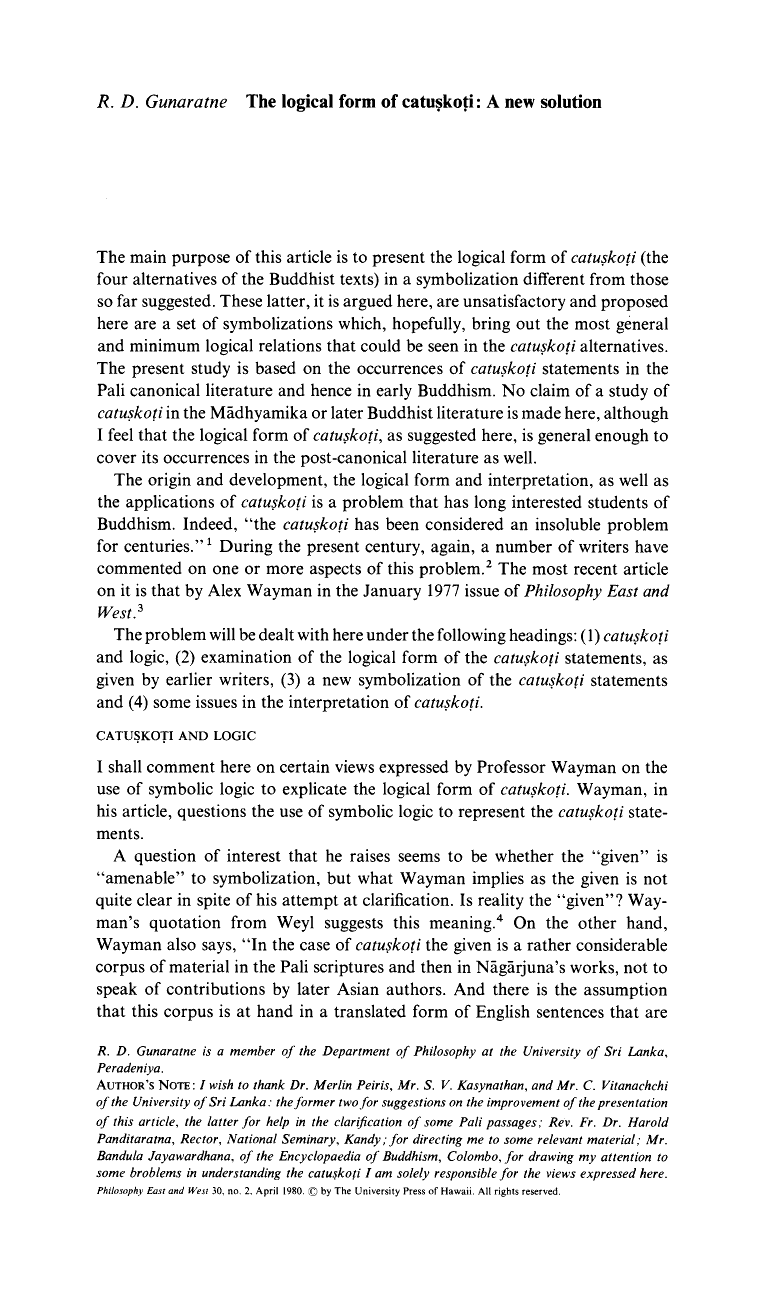
Na ̄ga ̄rjuna’s Logic
Aaron J. Cotnoir | aaron.cotnoir@uconn.edu| January 28, 2010
in G Priest , K Tanaka , Y Deguchi & J Garfield (eds) , The Moon Points Back . Oxford University Press . 2015
https://research-repository.st-andrews.ac.uk/handle/10023/11329
“The Catuskoti as a bilattice.”
Onishi, Takuro.
“Rationality, Argumentation and Embarrassment: A Study of Four Logical Alternatives (Catuṣkoṭi) in Buddhist Logic.”
Bharadwaja, V. K.
Philosophy East and West 34, no. 3 (1984): 303–19. https://doi.org/10.2307/1398631.
https://www.jstor.org/stable/1398631

RECAPTURE, TRANSPARENCY, NEGATION AND A LOGIC FOR THE CATUSKOTI
Kreutz, Adrian (2019).
Comparative Philosophy 10 (1).
https://philpapers.org/rec/KRERTN-3
The recent literature on Nāgārjuna’s catuṣkoṭi centres around Jay Garfield’s and Graham Priest’s interpretation. It is an open discussion to what extent their interpretation is an adequate model of the logic for the catuskoti, and the Mūla-madhyamaka-kārikā. Priest and Garfield try to make sense of the contradictions within the catuskoti by appeal to a series of lattices – orderings of truth-values, supposed to model the path to enlightenment. They use Anderson & Belnaps’s framework of First Degree Entailment. Cotnoir has argued that the lattices of Priest and Garfield cannot ground the logic of the catuskoti. The concern is simple: on the one hand, FDE brings with it the failure of classical principles such as modus ponens. On the other hand, we frequently encounter Nāgārjuna using classical principles in other arguments in the MMK. There is a problem of validity. If FDE is Nāgārjuna’s logic of choice, he is facing what is commonly called the classical recapture problem: how to make sense of cases where classical principles like modus pones are valid? One cannot just add principles like modus pones as assumptions, because in the background paraconsistent logic this does not rule out their negations. In this essay, I shall explore and critically evaluate Cotnoir’s proposal. In detail, I shall reveal that his framework suffers collapse of the kotis. Taking Cotnoir’s concerns seriously, I shall suggest a formulation of the catuskoti in classical Boolean Algebra, extended by the notion of an external negation as an illocutionary act. I will focus on purely formal considerations, leaving doctrinal matters to the scholarly discourse – as far as this is possible.
On the relationship of Advaita Vedānta and Mādhyamika Buddhism
Reynolds, Eric T.
University of British Columbia
Date Issued. 1975
https://open.library.ubc.ca/media/stream/pdf/831/1.0093585/1
https://open.library.ubc.ca/soa/cIRcle/collections/ubctheses/831/items/1.0093585
Paradox and Negation in the Upanishads, Buddhism and the Advaita Vedanta of Sankaracarya (India)
Thompson, Heather. California Institute of Integral Studies
ProQuest Dissertations Publishing, 1982. 8400050.
This dissertation explores the uses of Paradox and Negation–in contrast and comparison–through the Upanishads and Buddhism to the Advaita Vedanta of Sankara. Paradox and Negation employed are not of ordinary parlance but are philosophic and dialectic tools indicating a state beyond the world of appearances–the Supreme.The Upanishads indicate the Supreme state by positing the Transcendent Atman–The Transcendent Subjectivity–and the Transcendent Brahman–the Transcendent Existentiality. In both aspects, the Supreme is seen as the antecedent state to the nest of appearances: Its existence supports all phenomena. By juxtaposing two apparently incongruous statements–thus producing a Paradox–the Upanishadic seers pushed the mind beyond its normal boundaries into a meditative insight. Similarly, through Negation, the seers denied the self-sustaining validity of phenomena.The Buddha, in contrast, forwarded a pragmatic’ philosophy, refusing to speculate about the existence or nature of the Supreme. Rather, he examined the conditions of daily life, their cause, their cessation and the route to their cessation. Passing through the nominalist teachers of the Hinayana school to the Mahayana school, a growing use of Paradox and Negation is seen and culminates in the dialectics of Nagarjuna. Nagarjuna pushed Paradox and Negation to extremes in his Catuskoti, four-fold argument, which revealed the logical inadequacies of all concepts. They have only causal or relational validity within the boundaries of the intellect. Outside that boundary, they have no self-nature or existence.Sankara, in his Advaita Vedanta, rising to another level on the spiral of Indian philosophy, takes from the teachings of the previous two traditions and elaborates and develops both. He recognizes that the phenomenal world has reality–but a temporary one. It exists only so long as the mind is held in sway by illusion and ignorance. Once the mind has been restored to its true state–which is a meditatively disciplined one–the phenomenal world is seen as having relative existence only and as totally dependent on the Supreme Brahman.The uses of Paradox and Negation by the three schools will be examined as contrasts and complements to each other.
“Who Understands the Four Alternatives of the Buddhist Texts?”
Wayman, Alex.
Philosophy East and West 27, no. 1 (1977): 3–21. https://doi.org/10.2307/1397697.
https://www.jstor.org/stable/1397697
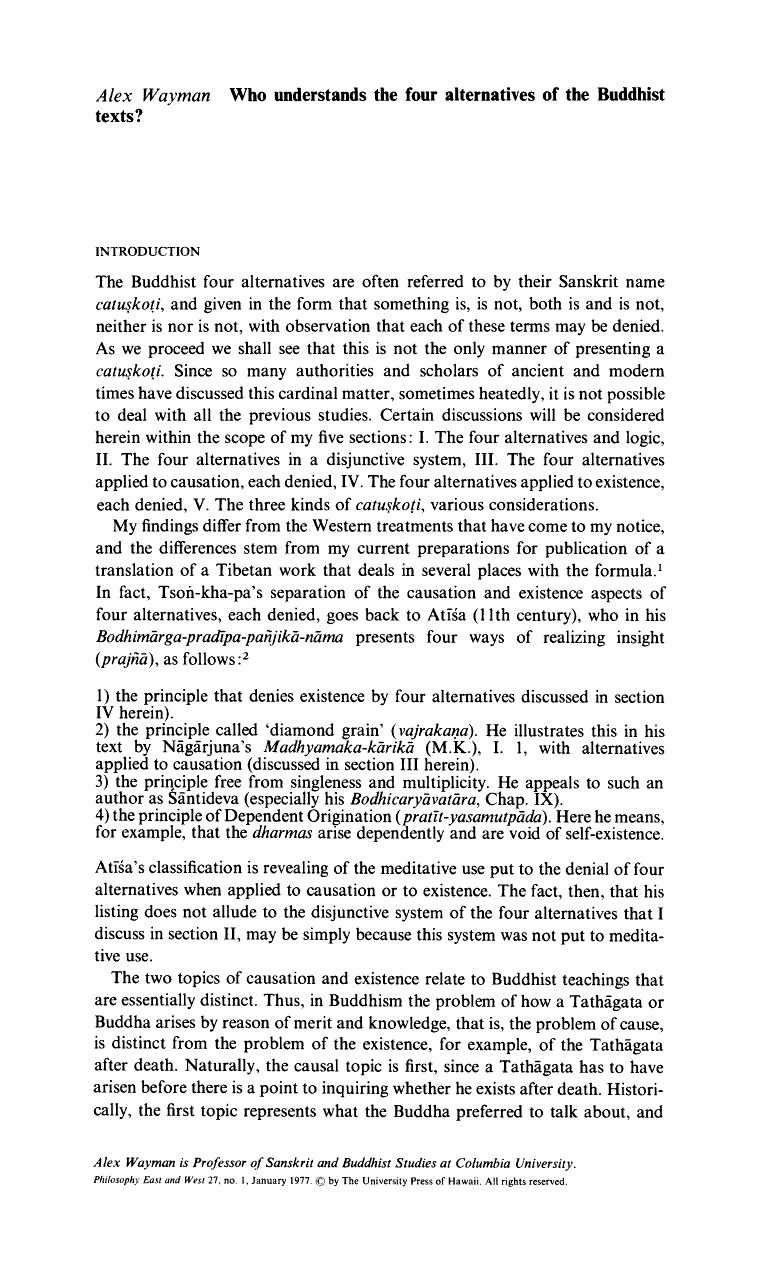
THE LOGIC OF THE CATUSKOTI
GRAHAM PRIEST
Comparative Philosophy Volume 1, No. 2 (2010): 24-54 Open Access / ISSN 2151-6014 http://www.comparativephilosophy.org
CONTRADICTION AND RECURSION IN BUDDHIST PHILOSOPHY:
FROM CATUṢKOṬI TO KŌAN
Kreutz, Adrian (2019).
In Takeshi Morisato & Roman Pașca (eds.), Asian Philosophical Texts Vol. 1. Milano: Mimesis International. pp. 133-162.
https://philarchive.org/rec/KRECAR-2
Cutting Corners: A Critical Note on Priest’s Five-Valued Catuṣkoṭi.
Kapsner, Andreas (2020).
Comparative Philosophy 11 (2).
https://philpapers.org/rec/KAPCCA-3
https://scholarworks.sjsu.edu/comparativephilosophy/vol11/iss2/10/
The Fifth Corner Re-Examined: Reply to Priest
Andreas Kapsner January 24, 2022
“Don’t be so Fast with the Knife: A Reply to Kapsner,”
PRIEST, Graham (2020)
Comparative Philosophy: Vol. 11: Iss. 2, Article 11.
Available at: https://scholarworks.sjsu.edu/comparativephilosophy/vol11/iss2/11
The Fifth Corner of Four: An Essay on Buddhist Metaphysics and the Catuskoti.
Priest, Graham (2018).
Oxford, England: Oxford University Press.
https://philpapers.org/rec/PRITFC
Interpreting Interdependence in Fazang’s Metaphysics.
Jones, Nicholaos (2022).
Journal of East Asian Philosophy 2:35-52.
On Buddhist Logic
Adrian Kreutz
Thesis
MA by Research
University of Birmingham
Department of Philosophy
https://philpapers.org/rec/KREOBL
Abstract
This thesis is the attempt to find a logical model for, and trace the history of, the catuṣkoṭi as it developed in the Indo-Tibetan milieu and spread, via China, to Japan. After an introduction to the history and key-concepts of Buddhist philosophy, I will finish the first chapter with some methodological considerations about the general viability of comparative philosophy. Chapter §2 is devoted to a logical analysis of the catuṣkoṭi. Several attempts to model this fascinating piece of Buddhist philosophy with the tools of classical logic shall be debunked. A paraconsistent alternative will be discussed but eventually dismissed. As a rejoinder, I shall propose a model for the catuṣkoṭi with the help of speech-acts. The remainder of this chapter will look at Chinese and Japanese forms of the catuṣkoṭi which I shall model in a quasi-recursive system. The third and final chapter will look at the Kyoto School’s soku-hi dialectics which ties together the different threads of this essay. I will criticise an established, classical model of the soku-hi dialectics and offer an alternative with a second-order paraconsistent semantics.
Indian Logic
Wikipedia
https://en.wikipedia.org/wiki/Indian_logic
“The Logic of Four Alternatives.”
Jayatilleke, K. N.
Philosophy East and West 17, no. 1/4 (1967): 69–83. https://doi.org/10.2307/1397046.
https://www.jstor.org/stable/1397046

A Russellian Analysis of Buddhist Catuskoti.
Jones, Nicholaos (2020).
Comparative Philosophy 11 (2):63-89.
https://scholarworks.sjsu.edu/comparativephilosophy/vol11/iss2/6/
The Catuskoti
by Peter Fumich
An essential principal to Buddhism is non-dualism. However, the Catuskoti is clearly a system still immersed in dualism. This sort of dualism is more like that of the dual in Tao. Taken by themselves, the two relative states contain within themselves the nature of the absolutes. The only thing which differentiates are the notions both, neither. It is much like the yin and yang symbol. However, more accurately as we go on we see a fractal emerge. Hence, the ultimate truth, one in which we seem to conceptually call the more subtle truth is an illusion. The infinite recursion of this extension hints at an ultimate truth arising at ¥. The conception which takes within it this very fractal nature is truly enlightened. A truth which is free from dualism is either entirely immersed within dualism, or it lacks the distinction of truth all together. The use of the Catuskoti serves the purpose to hint ultimately at a non-truth. Speaking in terms of tautologies and ineffables, we will see the Catuskoti is a conceptual elaboration of traditional dualism, absolute true and false. While this itself is a conceptual elaboration of the union of true and false, Sunyata or 0. Sunyata is a conceptual elaboration of itself, which of course cannot be explained conceptually because then it emerges from non-conceptual Sunyata to conceptual Sunyata of 0. We can hint at it by saying, as a truth space, the non-conceptual Sunyata be U, then the set of ineffables of U and tautologies of U forms the conceptual elaboration of U. It should be clear that careful attention to our use of V4, the Klein 4 group, will be sufficient to realize a conceptual grasp of the non-conceptual Sunyata. See http://jcer.com/index.php/jcj/article/view/420
https://jcer.com/index.php/jcj/article/view/420/445
https://11prompt.com/?q=node/491
Buddhist Logic and Quantum Dilemma
by Jayant Burde
ISBN: 9788120835528, 8120835522
Year of Publication: 2012
Binding: Hardcover
Edition: 1st
Paraconsistency and Dialetheism
Graham Priest
Handbook of the History of Logic
Volume 8, 2007, Pages 129-204
https://www.sciencedirect.com/science/article/abs/pii/S1874585707800069
The Many Valued and Nonmonotonic Turn in Logic
Graham Priest, in Handbook of the History of Logic, 2007
https://www.sciencedirect.com/topics/computer-science/valued-semantics
3.3 Contradiction in Eastern Philosophy
We have not finished with the Neoplatonist tradition yet, but before we continue with it, let us look at Eastern Philosophy, starting in India. Since very early times, the Law of Non-Contradiction has been orthodox in the West. This is not at all the case in India. The standard view, going back to before the Buddha (a rough contemporary of Aristotle) was that on any claim of substance there are four possibilities: that the view is true (and true only), that it is false (and false only), that it is neither true nor false, and that it is both true and false. This is called the catuskoti (four corners), or tetralemma.48Hence, the possibility of a contradiction was explicitly acknowledged. The difference between this view and the orthodox Western view is the same as that between the semantics of classical logic and the four-valued semantics for the relevant logic of First Degree Entailment (as we shall see). In classical logic, sentences have exactly one of the truth values T (true) and F (false). In First Degree Entailment they may have any combination of these values, including both and neither. Just to add complexity to the picture, some Buddhist philosopers argued that, for some issues, all or none of these four possibilities might hold. Thus, the major 2nd century Mahayana Buddhist philosopher Nāgārjuna is sometimes interpreted in one or other of these ways. Arguments of this kind, just to confuse matters, are also sometimes called catuskoti. Interpreting Nāgārjuna is a very difficult task, but it is possible to interpret him, as some commentators did, as claiming that these matters are simply ineffable.49
The Law of Non-Contradiction has certainly had its defenders in the East, though. It was endorsed, for example, by logicians in the Nyaayaa tradition. This influenced Buddhist philosophers, such as Darmakārti, and, via him, some Buddhist schools, such as the Tibetan Gelug-pa. Even in Tibet, though, many Buddhist schools, such as the Nyngma-pa, rejected the law, at least for ultimate truths.
Turning to Chinese philosophy, and specifically Taoism, one certainly finds utterances that look as though they violate the Law of Non-Contradiction. For example, in the Chuang Tzu (the second most important part of the Taoist canon), we find:50
That which makes things has no boundaries with things, but for things to have boundaries is what we mean by saying ‘the boundaries between things’. The boundaryless boundary is the boundary without a boundary.
A cause of these contradictions is not unlike that in Neoplatonism. In Taoism, there is an ultimate reality, Tao, which is the source and generator of everything else. As the Tao Te Ching puts it:51
The Tao gives birth to the One.
The One gives birth to the two.
The Two give birth to the three —
The Three give birth to every living thing.
It follows, as in the Western tradition, that there is nothing that can be said about it. As the Tao Te Ching puts it (ch. 1):
The Tao that can be talked about is not the true Tao.
The name that can be named is not the eternal name.
Everything in the universe comes out of Nothing.
Nothing — the nameless — is the beginning…
Yet in explaining this situation, we are forced to say things about it, as the above quotations demonstrate.
Chan (Zen) is a fusion of Mahayana Buddhism and Taoism. As might therefore be expected, the dialetheic aspects of the two metaphysics reinforce each other. Above all, then, Zen is a metaphysics where we find the writings of its exponents full of apparent contradictions. Thus, for example, the great Zen master Dōgen says:52
This having been confirmed as the Great Teacher’s saying, we should study immobile sitting and transmit it correctly: herein lies a thorough investigation of immobile sitting handed down in the Buddha-way. Although thoughts on the immobile state of sitting are not limited to a single person, Yüeh-shan’s saying is the very best. Namely: ‘thinking is not thinking’.
or:53
An ancient buddha said, ‘Mountains are mountains, waters are waters.’ These words do not mean that mountains are mountains; they mean that mountains are mountains. Therefore investigate mountains thoroughly…
Now interpreting all this, especially the Chinese and Japanese writings, is a hard and contentious matter. The writings are often epigrammatic and poetical. Certainly, the writings contain assertions of contradictions, but are we meant to take them literally? It might be thought not. One suggestion is that the contradictions are uttered for their perlocutionary effect: to shock the hearer into some reaction. Certainly, this sort of thing plays a role in Zen, but not in Mahayana Buddhism or Taoism. And even in Zen, contradictions occur in even the theoretical writings.
More plausibly, it may be suggested that the contradictions in question have to be interpreted in some non-literal way. For example, though ultimate reality is literally indescribable, what is said about it gives some metaphorical description of its nature. This won’t really work either, though. For the very reason that ultimate reality is indescribable is precisely because it is that which brings all beings into being; it can therefore be no being (and so to say anything about it is contradictory). At least this much of what is said about the Tao must be taken literally, or the whole picture falls apart.54
Indian Logic
https://tibetanbuddhistencyclopedia.com/en/index.php/Indian_logic
The Fifth Corner of Four: An Essay on Buddhist Metaphysics and the Catuṣkoṭi
Graham Priest, The Fifth Corner of Four: An Essay on Buddhist Metaphysics and the Catuṣkoṭi, Oxford University Press, 2018, 172pp., ISBN 9780198758716.
Reviewed by Mark Siderits, Seoul National University (Emeritus)
2019.05.18
The Fifth Corner of Four: An Essay on Buddhist Metaphysics and the Catuṣkoṭi
Reviewed by Ronald S. Green
Journal of Buddhist Ethics
ISSN 1076-9005 http://blogs.dickinson.edu/buddhistethics Volume 27, 2020
Review of Graham Priest: The Fifth Corner of Four. An Essay on Buddhist
Metaphysics and the Catuṣkoṭi, Oxford University Press, Oxford, 2018.
Mind, 2019, forthcoming.
Jan Westerhoff
https://ora.ox.ac.uk/objects/uuid:d8fa6404-3e65-4711-a7c9-e7c696e6602c/files/rb8515n415
https://ora.ox.ac.uk/objects/uuid:d8fa6404-3e65-4711-a7c9-e7c696e6602c
The Fifth Corner of Four: An Essay on Buddhist Metaphysics and the Catuṣkoṭi. By Graham Priest. New York: Oxford University Press, 2018. 208 pages.
Matthew T. Kapstein
École Pratique des Hautes Études, Paris, and the University of Chicago
Click to access 4-4-Kapstein-review.pdf
“Graham Priest, “The Fifth Corner of Four: An Essay on Buddhist Metaphysics and the Catuskoti.””.
Kreutz, A.
Philosophy in Review, Vol. 39, no. 3, Aug. 2019, pp. 146-8, https://journals.uvic.ca/index.php/pir/article/view/18802.
https://journals.uvic.ca/index.php/pir/article/view/18802
The Catuṣkoṭi, the Saptabhaṇgī, and “Non-Classical” Logic.
Priest, G. (2022).
In: Sarukkai, S., Chakraborty, M.K. (eds) Handbook of Logical Thought in India. Springer, New Delhi. https://doi.org/10.1007/978-81-322-2577-5_50
https://link.springer.com/referenceworkentry/10.1007/978-81-322-2577-5_50
References
- Anderson, A.R., and N.D. Belnap. 1962. Tautological entailments. Philosophical Studies 13: 9–24.Article Google Scholar
- Anderson, A.R., and N.D. Belnap. 1975. Entailment: The logic of relevance and necessity. Vol. I. Princeton: Princeton University Press.Google Scholar
- Battacharya, H.S, ed. and trans. 1967. Pramāṇa-naya-tattvālokālaṁkāra. Bombay: Jain Sahitya Vikas Mandal.Google Scholar
- Bharucha, F., and R.V. Kamat. 1984. Syādvāda theory of Jainism in terms of deviant logic. Indian Philosophical Quarterly 9: 181–187.Google Scholar
- Bochvar, D.A., and M. Bergmann. 1981. On a three-valued logical calculus and its application to the analysis of the paradoxes of the classical extended functional calculus. History and Philosophy of Logic 2: 87–112.Article Google Scholar
- Ganeri, J. 2002. Jaina logic and the philosophical basis of pluralism. History and Philosophy of Logic 23: 267–281.Article Google Scholar
- Garfield, J., trans. 1995. The fundamental wisdom of the middle way. New York: Oxford University Press.Google Scholar
- Halldén, S. 1949. The logic of nonsense. Uppsala: A. B. Lundequistska Bokhandlen.Google Scholar
- Jayatilleke, K.N. 1963. Early Buddhist theories of knowledge. London: George Allen and Unwin.Google Scholar
- Kassor, C. 2013. Is Gorampa’s “freedom from conceptual proliferations” dialetheist? A response to Garfield, Priest, and Tillemans. Philosophy East and West 63: 399–410.Article Google Scholar
- Kleene, S.C. 1938. Notation for ordinal numbers. Journal of Symbolic Logic 3: 150–151.Article Google Scholar
- Kleene, S.C. 1952. Introduction to metamathematics. Amsterdam: North Holland Publishers.Google Scholar
- Koller, J.M., and P. Koller, eds. 1991. A sourcebook in Asian philosophy. Upper Saddle River: Prentice Hall.Google Scholar
- Marconi, D. 1979. La formalizzazione della dialettica. Turin: Rosenberg & Sellier.Google Scholar
- Matilal, B.K. 1981. The central philosophy of Jainism (Anekānta-Vāda). Ahmedabad: L. D. Institute of Indology.Google Scholar
- Ñāṇamoli, Bikkhu, and Bikkhu Bodhi, trans. 1995. The middle length discourses of the Buddha. Somerville: Wisdom Publications.Google Scholar
- Oppy, G. 2018. Ontological arguments. Cambridge: Cambridge University Press.Book Google Scholar
- Priest, G. 1979. Logic of paradox. Journal of Philosophical Logic 8: 219–214.Article Google Scholar
- Priest, G. 1995. Beyond the limits of thought. Cambridge: Cambridge University Press. 2nd edn, Oxford: Oxford University Press, 2002.Google Scholar
- Priest, G. 2008. Introduction to non-classical logic. Cambridge: Cambridge University Press.Book Google Scholar
- Priest, G. 2013. Nāgārjuna’s Mūlamadhyakamakārika. Topoi 32: 129–134.Article Google Scholar
- Priest, G. 2014a. Plurivalent logic. Australasian Journal of Logic 11: 1. http://ojs.victoria.ac.nz/ajl/article/view/1830.Article Google Scholar
- Priest, G. 2014b. Speaking of the ineffable…. In Nothingness in Asian philosophy, ed. J. Lee and D. Berger. London: Routledge. Chapter 7.Google Scholar
- Priest, G. 2018. The fifth corner of four. Oxford: Oxford University Press.Book Google Scholar
- Priest, G. 2019. Natural deduction for systems in the FDE family. In New essays on Belnap-Dunn logic, ed. H. Omori and H. Wansing, 279–292. Berlin: Springer.Chapter Google Scholar
- Raju, P. 1954. The principle of four-cornered negation in Indian philosophy. Review of Metaphysics 7: 694–713.Google Scholar
- Sarkar, T. 1992. Some reflections on Jaina Anekāntavāda and Syādvada. Jadavpur Journal of Philosophy 2: 13–38.Google Scholar
- Siderits, M., and Katsura, S., trans. 2013. Nāgārjuna’s middle way. Boston: Wisdom Publications.Google Scholar
- Stcherbatsky, F.T. 1962. Buddhist logic. New York: Dover Publications.Google Scholar
None of the Above: The Catuṣkoṭi in Indian Buddhist Logic.
Priest, G. (2015).
In: Beziau, JY., Chakraborty, M., Dutta, S. (eds) New Directions in Paraconsistent Logic. Springer Proceedings in Mathematics & Statistics, vol 152. Springer, New Delhi. https://doi.org/10.1007/978-81-322-2719-9_24
https://link.springer.com/chapter/10.1007/978-81-322-2719-9_24?fromPaywallRec=true#citeas
References
- Deguchi, Y., Garfield, J., Priest, G.: The way of the dialetheist: contradictions in buddhism. Philos. East West 58, 395–402 (2008)Article Google Scholar
- Garfield, J.: The Fundamental Principles of the Middle Way: Nāgārjuna’s Mūlamadhyamikakārikā. Oxford University Press, New York (1995)Google Scholar
- Garfield, J., Priest, G.: Nāgārjuna and the limits of thought. Philos. East West 53, 1–21 (2003) (Reprinted as ch. 5 of Garfield’s, Empty Words. Oxford University Press, New York (2002) and as ch. 16 Priest (2002))Google Scholar
- Garfield, J., Priest, G.: Mountains are Just Mountains (2009) (ch. 7 of D’Amato, M., Garfield, J., Tillemans, T. (eds.): Pointing at the Moon: Buddhism, Logic, Analytic Philosophy. Oxford University Press, New York)Google Scholar
- Kassor, C.: Is Gorampa’s “Freedom from Conceptual Proliferations” dialetheist? A response to Garfield, Priest, and Tillemans. Philos. East West 63, 399–410 (2013)Article Google Scholar
- Priest, G.: Hypercontradictions. Logique et Analyse 107, 237–243 (1984)MathSciNet Google Scholar
- Priest, G.: Paraconsistent Logic. In: Gabbay, D., Guenther, D. (eds.) Handbook of Philosophical Logic, 2nd edn, Vol. 6, pp. 287–393. Kluwer Academic Publishers, Dordrecht (2002)Google Scholar
- Priest, G.: Beyond the Limits of Thought, 2nd edn. Oxford Unversity Press, Oxford (2002)Google Scholar
- Priest, G.: The Limits of Language. In: Brown, K. (ed.) Encyclopedia of Language and Linguistics, 2nd edn, Vol. 7, pp. 156–159. Elsevier, Amsterdam (2005)Google Scholar
- Priest, G.: Introduction to Non-Classical Logic: From If to Is. Cambridge University Press, Cambridge (2008)Google Scholar
- Priest, G.: Jaina logic: a contemporary perspective. History Philos. Logic 29, 263–278 (2008)Google Scholar
- Priest, G.: The logic of the Catuṣkoṭi. Comp. Philos. 1, 32–54 (2010)Google Scholar
- Priest, G.: Plurivalent logic. Australas. J. Logic 11 (2014) article 1. http://ojs.victoria.ac.nz/ajl/article/view/1830
- Radhakrishnan, S., Moore, C. (eds.): A Source Book in Indian Philosophy. Princeton University Press, Princeton (1957)Google Scholar
- Raju, P.: The principle of four-cornered negation in Indian philosophy. Rev. Metaphys. 7, 694–713 (1953)Google Scholar
- Robinson, R.: Some logical aspects of Nāgārjuna’s system. Philos. East West 6, 291–308 (1956)Article Google Scholar
- Ruegg, D.: The uses of the four positions of the Catuṣkoṭi and the problem of the description of reality in Mahāyāna buddhism. J. Indian Philos. 5, 1–71 (1977)Article Google Scholar
- Scherbatsky, Th: Buddhist Logic, vol. 1. Matilal Banarsidass, Delhi (1993)Google Scholar
- Thanissaro: Cula-Malunkyovada Sutta: the shorter instructions to Malunkya. http://www.accesstoinsight.org/tipitaka/mn/mn.063.than.html. Accessed Mar 2010
- Tillemans, T.: Is buddhist logic non-classical or deviant? Chap. 9 of Scripture, Logic, Language: Essays on Dharmakīrti and his Tibetan Successors. Wisdom Publications, Boston (1999)Google Scholar
“Doxographical Appropriation of Nāgārjuna’s Catuṣkoṭi in Chinese Sanlun and Tiantai Thought”
Kantor, Hans Rudolf. 2021.
Religions 12, no. 11: 912. https://doi.org/10.3390/rel12110912
https://www.mdpi.com/2077-1444/12/11/912
One Negation, Two Ways of Using It: Prasajyapratiṣedha in Bhāviveka and Candrakīrti’s Argumentation1
Chen Hsun-Mei
National Taiwan University / Kyoto University / Harvard Yenching Institute Wang Wen-Fang
Professor, National Yang Ming University
Nāgārjuna’s Tetralemma in Yamauchi Tokuryū’s Philosophy
Romaric Jannel
https://philarchive.org/archive/JANNTI
Three new genuine five-valued logics
Mauricio Osorio1 and Claudia Zepeda2
1 Universidad de las Am ́ericas-Puebla,
2 Benem ́erita Universidad Ato ́noma de Puebla {osoriomauri,czepedac}@gmail.com
https://www.sciencedirect.com/science/article/pii/S1571066120300888
Many-Valued Logic
SEP
https://plato.stanford.edu/entries/logic-manyvalued/
Many-valued logics. A mathematical and computational introduction..
Augusto, Luis M. (2020).
London: College Publications.
https://philarchive.org/rec/AUGMLA
Many-valued logics are those logics that have more than the two classical truth values, to wit, true and false; in fact, they can have from three to infinitely many truth values. This property, together with truth-functionality, provides a powerful formalism to reason in settings where classical logic—as well as other non-classical logics—is of no avail. Indeed, originally motivated by philosophical concerns, these logics soon proved relevant for a plethora of applications ranging from switching theory to cognitive modeling, and they are today in more demand than ever, due to the realization that inconsistency and vagueness in knowledge bases and information processes are not only inevitable and acceptable, but also perhaps welcome. The main modern applications of (any) logic are to be found in the digital computer, and we thus require the practical knowledge how to computerize—which also means automate—decisions (i.e. reasoning) in many-valued logics. This, in turn, necessitates a mathematical foundation for these logics. This book provides both these mathematical foundation and practical knowledge in a rigorous, yet accessible, text, while at the same time situating these logics in the context of the satisfiability problem (SAT) and automated deduction. The main text is complemented with a large selection of exercises, a plus for the reader wishing to not only learn about, but also do something with, many-valued logics.
“Many-valued logic and its philosophy.”
Malinowski, Grzegorz.
In The Many Valued and Nonmonotonic Turn in Logic (2007).
Improving the efficiency of using multivalued logic tools.
Suleimenov, I.E., Vitulyova, Y.S., Kabdushev, S.B. et al.
Sci Rep 13, 1108 (2023). https://doi.org/10.1038/s41598-023-28272-1
https://www.nature.com/articles/s41598-023-28272-1
Improving the efficiency of using multivalued logic tools: application of algebraic rings.
Suleimenov, I.E., Vitulyova, Y.S., Kabdushev, S.B. et al.
Sci Rep 13, 22021 (2023). https://doi.org/10.1038/s41598-023-49593-1
https://www.nature.com/articles/s41598-023-49593-1
An Introduction to Many-valued Logics
https://www.routledge.com/An-Introduction-to-Many-valued-Logics/Ackermann/p/book/9780367426040
“Foreword: Three-Valued Logics and Their Applications.”
Cobreros, Pablo, Paul Égré, David Ripley, and Robert van Rooij.
Journal of Applied Non-Classical Logics 24, no. 1–2 (2014): 1–11. doi:10.1080/11663081.2014.909631.
https://www.tandfonline.com/doi/full/10.1080/11663081.2014.909631
The Two-Valued Iterative Systems of Mathematical Logic.
Post, Emil L..
(AM-5), Volume 5, Princeton: Princeton University Press, 1942. https://doi.org/10.1515/9781400882366
Indian Modernity: Contradictions, Paradoxes and Possibilities
Author Avijit Pathak
Avijit Pathak is Professor at the Centre for the Study of Social Systems, Jawaharlal Nehru University, New Delhi.
Publisher Taylor & Francis, 2023
ISBN 1003830838, 9781003830832
Length 254 pages
‘Quintum Non-Datur‘, The Fifth Corner of Four: An Essay on Buddhist Metaphysics and the Catuskoti
Priest, Graham,
(Oxford, 2018; online edn, Oxford Academic, 20 Dec. 2018), https://doi.org/10.1093/oso/9780198758716.003.0002, accessed 21 May 2024.
Levels of truth and reality in the philosophies of Descartes and samkara.
Schroeder, Craig (1985).
Philosophy East and West 35 (3):285-293.
https://doi.org/10.2307/1399157.
https://www.jstor.org/stable/1399157
https://www.proquest.com/openview/877c873a024f65b35ce731710fbca754/1?pq-origsite=gscholar&cbl=1820847
In the West, the general tendency of philosophers has been to understand things as being either real or unreal and to view propositions as either true or false. It is assumed that that which is real or true is opposite and exclusive of that which is unreal or untrue and that there can be no mediating ground. Only rarely does one find a philosopher who attempts to qualify truth and reality, that is, to hold that one thing might be, to some degree, more or less real than another, or to hold that one proposition could be more true than a second, while remaining less true than a third. On the contrary, philosophy in the West has generally been a quest to determine more clearly what is real and true and to contrast it more sharply with what is held to be unreal and untrue.
Often in this quest, however, philosophers display a tendency to qualify truth and reality even while trying to deny or exclude the possibility of such qualification. In Descartes’ writings, this qualification is set forth through his method of radical doubt as exercised in the Meditations. In his search for the real and the true, Descartes proceeds to doubt all of his former, commonsense beliefs. In this process, starting with that which is most easily doubted, that which seems the least ontologically and epistemologically well-grounded, he proceeds to submit to radical doubt beliefs of firmer and firmer ontological and epistemological footing, in search of something indubitable upon which to rebuild the structure of truth and reality. In spite of the fact that this method of radical doubt results in a reassertion of that which Descartes had more naively believed all along, it is instructive to compare the mediating levels observed by Descartes in his method to those of a non-Western philosopher who admits to qualified levels of truth and reality. Thus, while Descartes’ conclusions follow the more general Western pattern of drawing strict lines of demarcation between reality and nonreality, truth and untruth, we will concentrate more on his method, which stratifies and qualifies reality and truth prior to the drawing of these lines. Qualified levels of truth and reality are less of a problem for Indian philosophers. While India, too, has its schools of philosophy which admit to only two ontological or epistemological possibilities, one also finds in other schools a very careful and deliberate grading of reality and truth from levels of varying qualification to a level of ultimacy. Samkara’s Advaita Vedanta is one such school, and it is Samkara that will be considered in a comparison with Descartes. There are, strictly speaking, only one level of full truth and reality and one level· of full untruth and nonreality for Samkara. These extremes, however, are mediated by at least two other levels which are sadasadvilaksana,” other than real and unreal.” The reality or nonreality of these middle levels can only be understood in relation to the highest and lowest levels of reality. This ambiguity in their nature renders them anirvacanTya,” that about which we cannot speak.” For Samkara, there are only two sorts of things which are fully unreal,(1) the
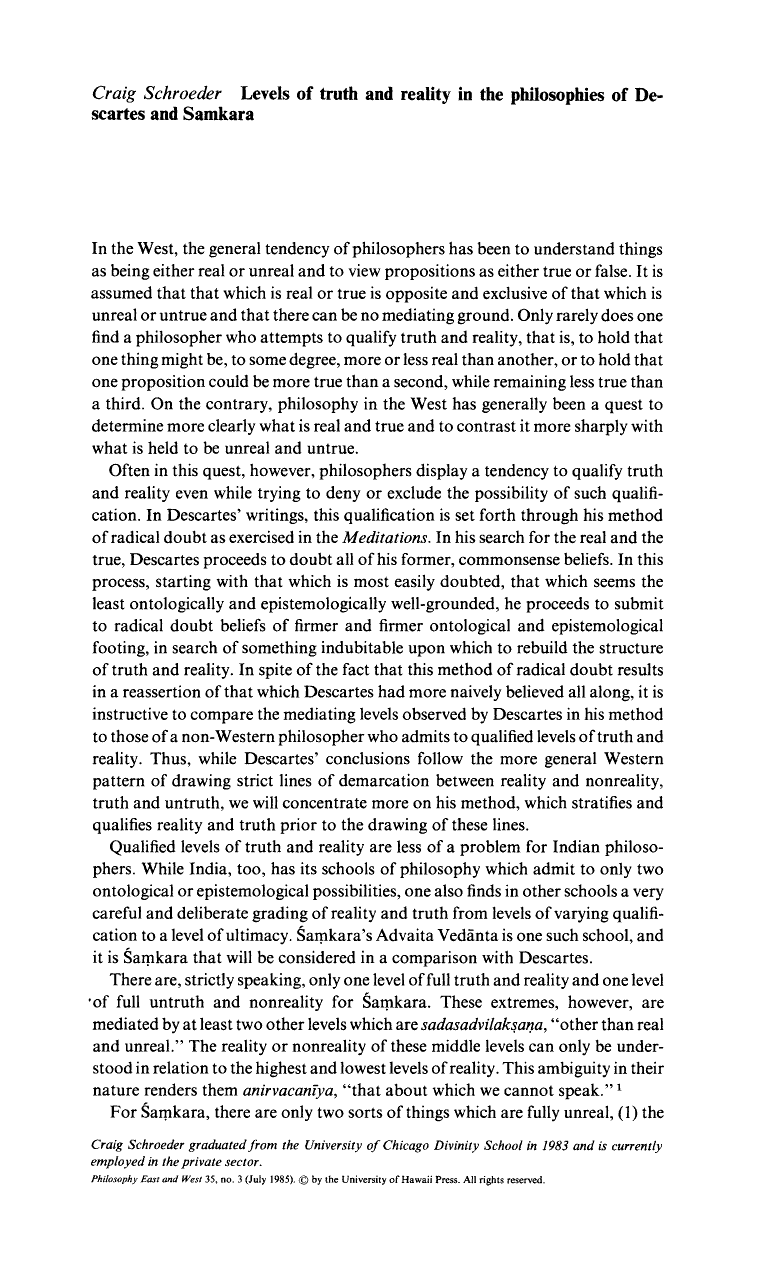
The Problem of Two Truths in Buddhism and Vedānta
Author G.M.C. Sprung
Edition illustrated
Publisher Springer Science & Business Media, 2012
ISBN 9401025827, 9789401025829
Length 132 pages
The Uses of the Four Positions of the “Catus-koti” and the Problem of the Description of Reality in Mahayana Buddhism
Journal of Indian Philosophy; Dordrecht, Holland Vol. 5, (Jan 1, 1977): 1.
https://www.jstor.org/stable/23438780

Four Corners—East and West.
Priest, G. (2011).
In: Banerjee, M., Seth, A. (eds) Logic and Its Applications. ICLA 2011. Lecture Notes in Computer Science(), vol 6521. Springer, Berlin, Heidelberg. https://doi.org/10.1007/978-3-642-18026-2_2
https://link.springer.com/chapter/10.1007/978-3-642-18026-2_2
References
- Garfield, J.: The Fundamental Principles of the Middle Way: Nāgārjuna’s Mūlamadhyamikakārikā. Oxford University Press, New York (1995)Google Scholar
- Garfield, J., Priest, G.: Nāgārjuna and the Limits of Thought. Philosophy East and West 53, 1–21 (2003); reprinted as Priest, G.: Beyond the Limits of Thought, 2nd (extended) edn., ch.16. Oxford University Press, Oxford (2002)Article Google Scholar
- Garfield, J., Priest, G.: Mountains are Just Mountains. In: D’Amato, M., Garfield, J., Tillemans, T. (eds.) Pointing at the Moon: Buddhism, Logic, Analytic Philosophy, ch. 7. Oxford University Press, New York (2009)Chapter Google Scholar
- Priest, G.: Hypercontradictions. Logique et Analyse 107, 237–243 (1984)Google Scholar
- Priest, G.: Paraconsistent Logic. In: Gabbay, D., Guenther, D. (eds.) Handbook of Philosophical Logic, 2nd edn., vol. 6, pp. 287–393. Kluwer Academic Publishers, Dordrecht (2002)Chapter Google Scholar
- Priest, G.: Introduction to Non-Classical Logic: from If to Is. Cambridge University Press, Cambridge (2008)Book MATH Google Scholar
- Priest, G.: The Logic of the Catuṣkoṭi. Comparative Philosophy 1, 32–54 (2010)Google Scholar
- Raju, P.: The Principle of Four-Cornered Negation in Indian Philosophy. Review of Metaphysics 7, 694–713 (1953)Google Scholar
- Ruegg, D.: The Uses of the Four Positions of the Catuṣkoṭi and the Problem of the Description of Reality in Mahāyāna Buddhism. Journal of Indian Philosophy 5, 1–71 (1977)Article Google Scholar
- Scherbatsky, T.: Buddhist Logic, vol. 1. Matilal Banarsidass, Delhi (1993)Google Scholar
- Tillemans, T.: Is Buddhist Logic Non-classical or Deviant? In: Scripture, Logic, Language: Essays on Dharmakīrti and his Tibetan Successors, ch. 9. Wisdom Publications, Boston (1999)Google Scholar
- Westerhoff, J.: Nāgārjuna’s Metaphysics: a Philosophical Introduction. Oxford University Press, Oxford (2010)Google Scholar
“The Avyākatāni and the Catuṣkoṭi Form in the Pāli Sutta Piṭaka, 2.”
Rigopoulos, Antonio.
East and West 43, no. 1/4 (1993): 115–40.
Published By: ISMEO (International Association for Mediterranean and Oriental Studies)
http://www.jstor.org/stable/29757086.

“THE ARGUMENTS OF NĀGĀRJUNA IN THE LIGHT OF MODERN LOGIC.”
YU-KWAN, NG.
Journal of Indian Philosophy 15, no. 4 (1987): 363–84.
http://www.jstor.org/stable/23445484.
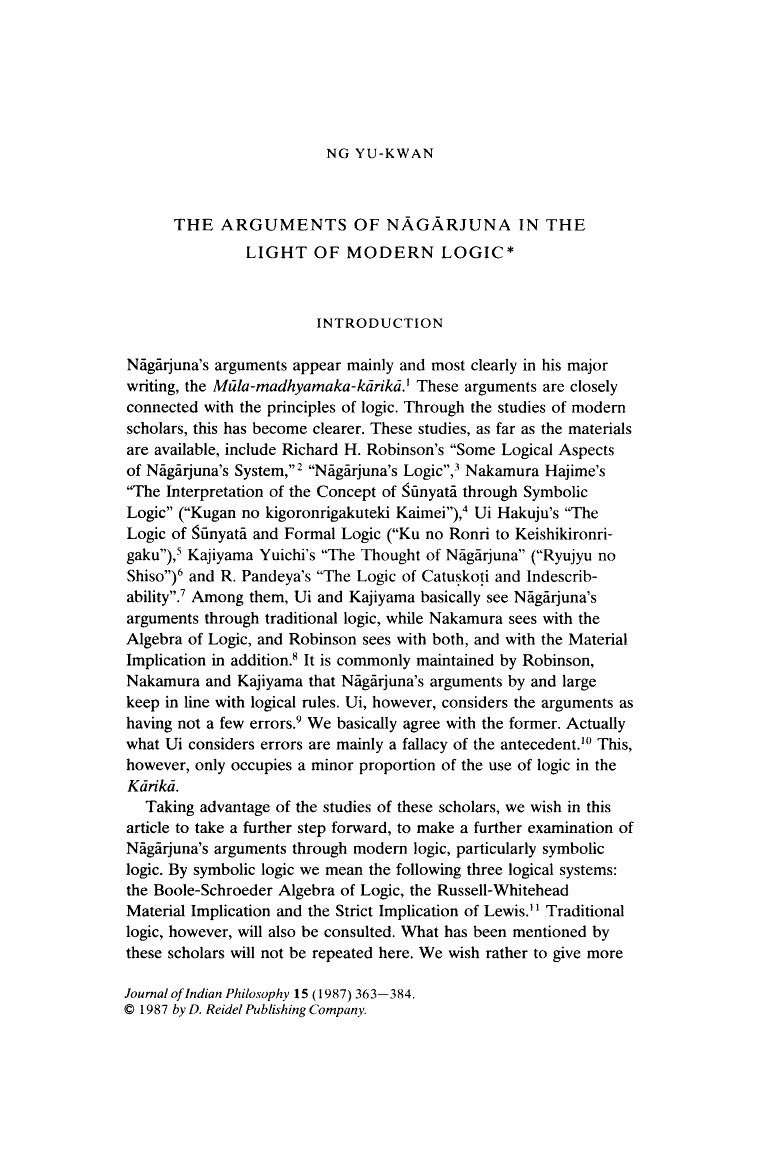
“SOME LOGICAL ISSUES IN MADHYAMAKA THOUGHT.”
GALLOWAY, BRIAN.
Journal of Indian Philosophy 17, no. 1 (1989): 1–35.
http://www.jstor.org/stable/23445510.

“NĀGĀRJUNA’S ‘CATUṢKOṬI.’”
WESTERHOFF, J.
Journal of Indian Philosophy 34, no. 4 (2006): 367–95. http://www.jstor.org/stable/23497268.

“RATIONALITY IN EARLY BUDDHIST FOUR FOLD LOGIC.”
HOFFMAN, F. J.
Journal of Indian Philosophy 10, no. 4 (1982): 309–37. http://www.jstor.org/stable/23445371.

On Garfield and Priest’s interpretation of the use of the catuskoti in Mūlamadhyamakakārikā.
Wang, C., & Wen-fang, W. (2024).
Asian Philosophy, 1–21. https://doi.org/10.1080/09552367.2024.2309769
https://www.tandfonline.com/doi/abs/10.1080/09552367.2024.2309769
References
- Austin, J. L. (1962). How to do things with words. Oxford University Press.
- Beall, J. (2009). Spandrels of truth. Clarendon Press. Google Scholar
- Belnap, N. D. (1977). A useful four-valued logic. In J. M. Dunn & G. Epstein (Eds.), Modern uses of multiple-valued logics(pp. 8–37). Reidel. Google Scholar
- Chen, H. M., & Wang, W. F. (2020). One negation, two ways of using it: Prasajyapratiedha in Bh¯aviveka and Candrak¯ırti’s argumentation. Tetsugaku, 4, 185–206. https://philosophy-japan.org/wpdata/wp-content/uploads/2020/06/Chen-Hsun-Mei-National-Taiwan-University-Kyoto-University-Harvard-Yenching-Institute-Wang-Wen-Fang-2020.pdfGoogle Scholar
- Cotnoir, A. J. (2015). N¯ag¯arjuna’s logic. In T. Koji, Y. Deguchi, J. Garfield, & P. Graham (Eds.), The moon points back (pp. 176–188). Oxford University Press. Google Scholar
- Davidson, D. (1984). Inquiries into truth and interpretation. Clarendon Press. Google Scholar
- Field, H. (2008). Saving truth from paradox. Oxford University Press. Google Scholar
- Frege, G. (1892). On Sense and Reference. In P. Geach & M. Black (Eds.), Translation from the philosophical writings of Gottlob Frege (pp. 56–78). Blackwell, 1952 . Google Scholar
- Garfield, J. L. (1995). The fundamental wisdom of the middle way: N¯ag¯arjuna’s Mu¯lamadhyamakak¯arik¯a. Oxford University Press. Google Scholar
- Garfield, J. L., & Priest, G. (2002). N¯ag¯arjuna and the limits of thought. In J. Garfield (Ed.), Empty words (pp. 86–108). Oxford University Press. Google Scholar
- Garfield, J. L., & Priest, G. (2009). Mountains are just mountains. In M. D’amato, J. L. Garfield, & T. J. F. Tillemans (Eds.), Pointing at the moon – Buddhism, logic, analytic philosophy (pp. 71–82). Oxford University Press. Google Scholar
- Kripke, S. (1975). Outline of a theory of truth. The journal of philosophy, 72(19), 690–716. https://doi.org/10.2307/2024634 Web of Science ®Google Scholar
- Matilal, B. K. (2005). Epistemology, logic, and grammar in Indian philosophical analysis. Oxford University press. Google Scholar
- Priest, G. (2006). In contradiction: A study of the transconsistent. Oxford University Press. Google Scholar
- Priest, G. (2010). The logic of the catuskoti. Comparative philosophy, 1(2), 24–54. https://doi.org/10.31979/2151-6014(2010).010206 Google Scholar
- Priest, G. (2018). The fifth corner of four: An essay on Buddhist metaphysics and the catuskoti. Oxford University Press. Google Scholar
- Restall, R. (2005). Multiple conclusions. In Logic, Methodology and Philosophy of Science: Proceedings of the 12th International Congress, Oviedo (pp. 189–206). Kings College Publications. Google Scholar
- Rumfitt, I. (2017). The liar without truth. In B. Armour-Garb (Ed.), Reflections on the liar (pp. 191–211). Oxford University Press. Google Scholar
- Sider, T. (2007). Logic for philosophy. Oxford University Press. Google Scholar
- Westerhoff, J. (2009). Nāgārjuna’s Madhyamaka – a philosophical introduction. Oxford University Press. Google Scholar
- Whitehead, A. N., & Russell, B. (1962). Principia mathematica. Cambridge University Press. Google Scholar
The Deconstructionist Interpretation of Nagarjuna’s Catuskoti∗
Shi, Ruyuan (Chien-Yuan Hsu) PhD candidate, the Dep. of Religious Studies, the University of Calgary, Canada Sessional instructor, Mount Royal University, Canada
“INTRODUCTION: BUDDHISM AND CONTRADICTION.”
Tanaka, Koji.
Philosophy East and West 63, no. 3 (2013): 315–21. http://www.jstor.org/stable/43285829.

“DOES A TABLE HAVE BUDDHA-NATURE?”
Siderits, Mark.
Philosophy East and West 63, no. 3 (2013): 373–86. http://www.jstor.org/stable/43285836.
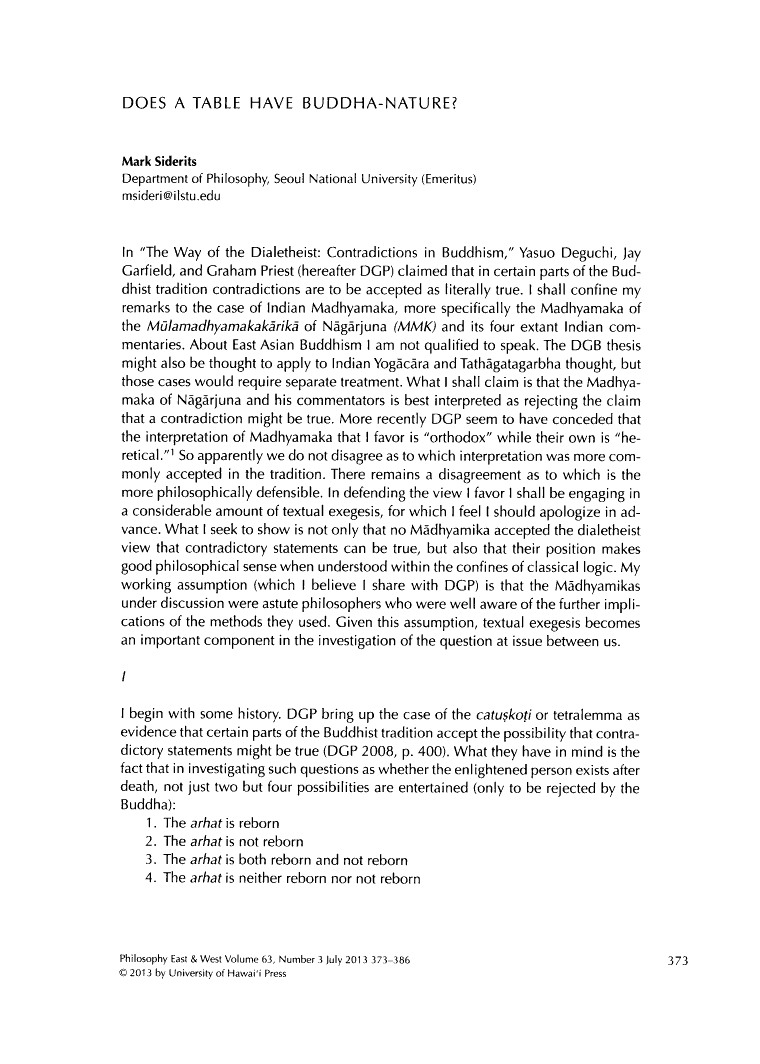
Buddhist Formal Logic, Part 1
Richard See Yee Chi
Edition reprint
Publisher Motilal Banarsidass Publ., 1984
ISBN 8120807308, 9788120807303
Length 304 pages
Reviewed Work: Buddhist Formal Logic
Richard S. Y. Chi
Review by: Douglas Dunsmore Daye
Philosophy East and West
Vol. 23, No. 4 (Oct., 1973), pp. 525-535 (11 pages)
Published By: University of Hawai’i Press
https://doi.org/10.2307/1397722.
https://www.jstor.org/stable/1397722
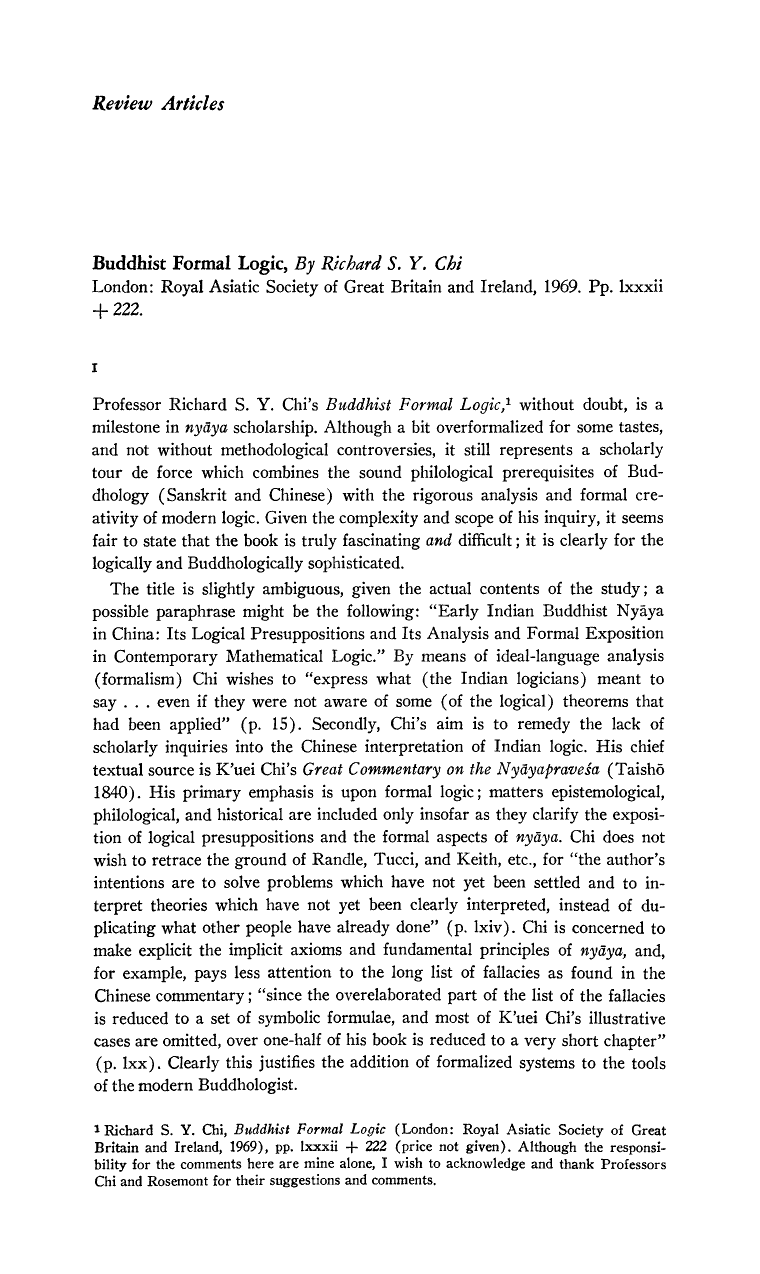
“The catuskoti: historical origins and modern interpretations.” (2021).
Alam Nizar, Syed Moynul.
“THE MĀDHYAMIKA ‘CATUṢKOṬI’ OR TETRALEMMA.”
CHAKRAVARTI, SITANSU S., and SITANSU S. CHAKRABARTI.
Journal of Indian Philosophy 8, no. 3 (1980): 303–6. http://www.jstor.org/stable/23440331.

Early Buddhist Theory of Knowledge
Edition 1st Edition First Published 1963
eBook Published 15 August 2013
Pub. Location London Imprint Routledge
DOI https://doi.org/10.4324/9781315888347
Pages 524
eBook ISBN 9781315888347
“Mysticism and Logic in Seng-Chao’s Thought.”
Robinson, Richard H.
Philosophy East and West 8, no. 3/4 (1958): 99–120. https://doi.org/10.2307/1397446.
https://www.jstor.org/stable/1397446

“The Four Levels of Pratītyasamutpāda According to the Fa-hua hsüan i.”
Bielefeldt, Carl.
Journal of the International Association of Buddhist Studies (1988): 7-29.
Nothingness in Asian philosophy.
Liu, JeeLoo, and Douglas L. Berger, eds.
New York: Routledge, 2014.
“CONTRADICTIONS IN DŌGEN.”
Tanaka, Koji.
Philosophy East and West 63, no. 3 (2013): 322–34. http://www.jstor.org/stable/43285830.
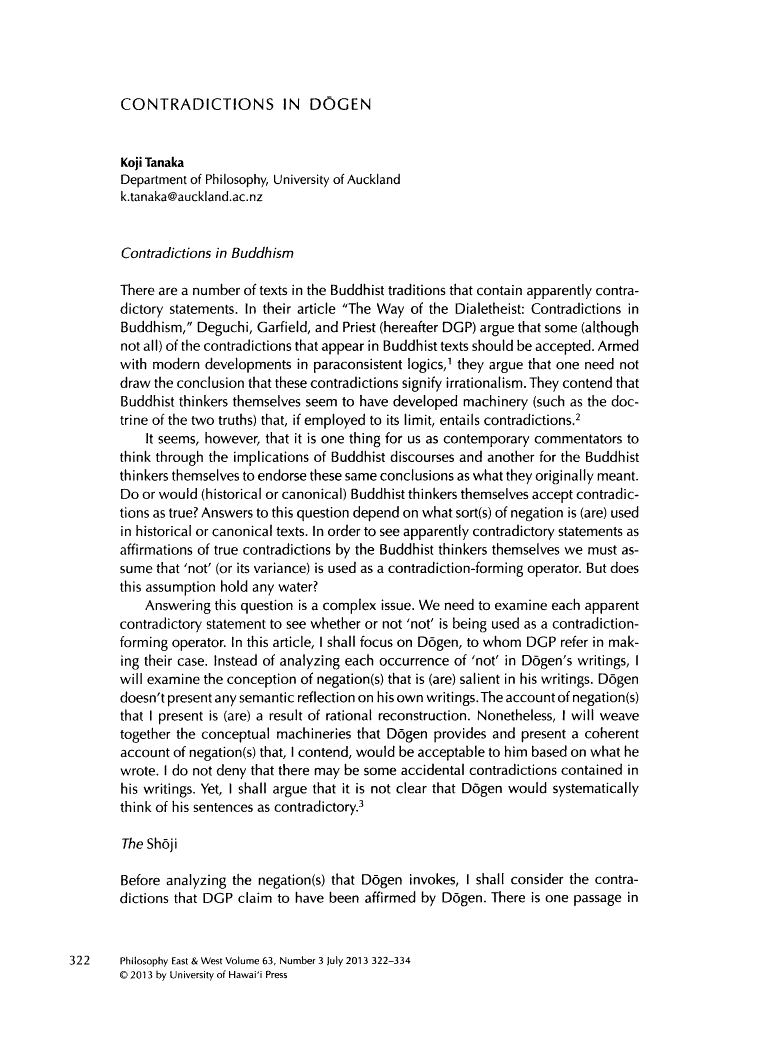
Emptiness, negation, and skepticism in Nāgārjuna and Sengzhao.
Nelson, E. S. (2023).
Asian Philosophy, 33(2), 125–144. https://doi.org/10.1080/09552367.2023.2179966
https://www.tandfonline.com/doi/abs/10.1080/09552367.2023.2179966
Some General Remarks on Negation and Paradox in Chinese Logic
Author: Klaus Butzenberger
Journal of Chinese philosophy 20, no. 3 (1993): 313-347.
Nagarjuna’s Madhyamaka: A Philosophical Introduction
Author Jan Westerhoff
Publisher Oxford University Press, 2009
ISBN 0199705119, 9780199705115
Length 256 pages
Izutsu’s Zen Metaphysics of I-Consciousness vis-à-vis Cartesian Cogito
Takaharu Oda
2020, Comparative Philosophy
Issue: 2
Volume: 11
Page Numbers: 90-112
Publication Date: 2020
Publication Name: Comparative Philosophy
https://doi.org/10.31979/2151-6014(2020).110207
What Can’t be Said: Paradox and Contradiction in East Asian Thought
Authors Yasuo Deguchi, Jay L. Garfield, Graham Priest, Robert H. Sharf
Publisher Oxford University Press, 2021
ISBN 0197526209, 9780197526200
Length 256 pages




















